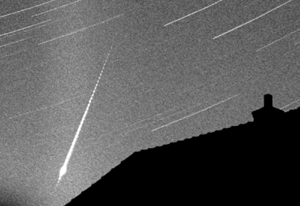|
Leonid MAC |
| home |
| View the shower |
| Mission Brief |
| Science Update |
| Media Brief |
| links |
LEONID DAILY NEWS: December 28, 2003
Quadrantid fireball photographed in 1995 by Hans Betlem, Dutch Meteor Society. The meteor image was interrupted by a rotating shutting, enabling us to measure the meteoroid's speed.
The Quadrantid shower will be visible under unusually good circumstances from the United States and Europe during the early morning of Sunday January 04, 2004. The peak of the shower is at 7:30 UT (08:30 a.m. MET, 02:30 a.m. EST, 23:30 p.m. PST), but the highest meteor rates are only visible in the early morning hours just before dawn, when the Moon has set. Observers in Europe and on the US east coast may see up to 62 meteors/hr, while observers on the west coast will see up to 49 meteors/hr under transparent clear skies in the 2-3 hours before dawn on Sunday morning.
The unique Quadrantid shower.
The Quadrantid shower is unique in that the meteoroids were released during the breakup of a comet nucleus and therefore originate from deep within the comet. They represent relatively large mm-cm sized fragments. Those are larger than the small dust grains collected by the Stardust mission when it will pass by comet Wild 2 on January 02. 2003 EH_1 may facilitate future astrobiology missions of an inactive, but relatively fresh comet surface in search of prebiotic molecules that may have been the building blocks of life.
2003: Dec 30 - Quadrantid parent comet observed Dec 28 - Good Quadrantid show on 2004 Jan 04 Dec 08 - Quadrantid parent discovered 2002: Nov 23 - "Shock" confirmed Nov 22 - New molecular band detected Nov 21 - Leonids tracked Nov 20 - Asteroids named after Leonid MAC participants Nov 19 - Leonid storms rich in faint meteors Oct 22 - Collecting meteoroid debris from snow cover Oct 21 - Highlights COSPAR/World Space Congress Aug 31 - First UV spectrum: Leonid from space 2001: Dec 11 - Shocking Leonid Dec 01 - Moon impacts Nov 26 - Near-IR persistent train emission Nov 24 - Results of near-real time flux measurements Nov 22 - Wowh! Optical meteor spectra 2000: Dec. 25 - Ursid shower circular IMO Dec. 24 - Ursid shows early release of sodium Dec. 23 - Ursid outburst confirmed Dec. 18 - Dec 22 Ursid outburst Nov. 20 - A bacterial fingerprint? Nov. 15 - HCN disappears mysteriously Nov. 14 - Meteor shower from space Nov. 13 - Organic fingerprint Nov. 12 - Train airglow chemistry Nov. 11 - Hard bits and persisting glows Nov. 10 - Meteoroid debris detected Nov. 09 - New meteor picture Nov. 08 - Spin city Nov. 07 - Meteors affect atmospheric chemistry Nov. 06 - Listen to this! Nov. 04 - Fear of heights? Nov. 03 - The pale (infra-red) dot Nov. 02 - Twin showers Nov. 01 - Leonids approaching Earth Oct. 31 - Prospects for Moon Impact Studies Oct. 30 - Comet dust crumbled less fine Today's news
| ||


